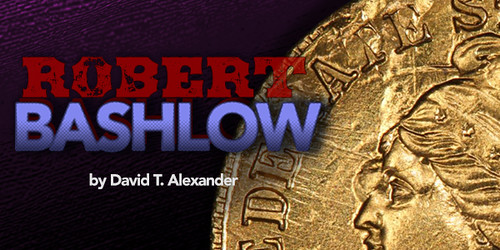
PREV ARTICLE
NEXT ARTICLE
FULL ISSUE
PREV FULL ISSUE
DAVID T. ALEXANDER ON ROBERT BASHLOW
CoinWeek published a nice article by David T. Alexander on September 6, 2016 about coin dealer and marketer Robert Bashlow.
Here's an excerpt; be sure to read the complete version online. -Editor

Bashlow’s early career as a professional numismatist blossomed in the heyday of the 1955 Double Date Lincoln cent, a marvelous Philadelphia Mint product that featured boldly doubled digits in the date and doubled lettering in the obverse legend. Apparently 20,000 to 24,000 examples were struck with this bungled obverse die and were mixed in with 10 million cents awaiting packaging and release into circulation. After this variety was discovered and publicized, its value skyrocketed. Fast-moving dealers bought and sold Double Date pieces at several points during their dramatic rise in an overheated coin market. Fortunes were made, and the young Bashlow racked up hefty profits. In the next phase of his career, Bashlow worked with wholesale dealer David Laties in importing and mass-marketing several types of modern British bronze coins to American collectors. Bashlow’s name became associated with such companies as White Oak Trading Co. and Williams Trading Co. in importing immense quantities of recent-date British bronze coins for sale to American collectors seeking entry into what appeared to be a new collecting area. After this, Bashlow’s interest was focused on the Centennial of the American Civil War, a multi-year event celebrated throughout the country. It included the issuance of dozens of official and private medals, ranging from the official national medal by sculptor Joseph Renier to coin-relief medals hailing the death of the first Confederate officer from Louisiana. Bashlow soon discovered a Civil War item of vastly greater significance: the pattern cent struck for the Confederacy by Philadelphia die sinker Robert Lovett Jr. soon after secession and the creation of the Confederate States of America. Bashlow’s involvement with this enigmatic coin merely continued controversies dating to its discovery in 1874. The dies vanished from public sight until they reappeared at the 1911 American Numismatic Association convention, exhibited by prominent collector Judson Brenner. Then they appear to have passed to acquisitive Union News mogul F.C.C. Boyd, longtime officer of the prestigious New York Numismatic Club. He in turn moved them on to dealer John J. Ford Jr. of New Netherland Coins. Always interested in usable dies, Ford was later famed for his interest in Western and Gold Rush numismatics. Showing cancellation lines and blobs of die rust, the Confederate cent dies were sold to the youthful Q. David Bowers, then launching a distinguished numismatic career. Based at the time in Binghamton, New York, Bowers made no use of the dies but sold them to a frequent visitor from New York City, the young Robert Bashlow. The possession and use of these dies brought Bashlow’s name before the larger American numismatic community.
Some 30,000 impressions were eventually made from these copy dies in a variety of different metals and die thicknesses as two-sided pieces and as impressions on rectangular planchets. These were relentlessly advertised with double-truck (facing pages) ads in the numismatic press, especially Coin World. The original and copy dies were later donated with requisite fanfare to the Smithsonian Institute. All Bashlow ads were bold and flashy, featuring borders of Confederate flags, garish typefaces presenting a barrage of breathless claims about the great opportunities that this SECOND RESTRIKE OF THE CONFEDERATE CENT offered to the trusting reader. Intense controversy erupted over these claims. Just what was a “Second Restrike”? What were “copy dies” and why should anything struck from them have any value at all? And besides, who was this Robert Bashlow? To read the complete article, see:
THE BOOK BAZARREWayne Homren, Editor The Numismatic Bibliomania Society is a non-profit organization promoting numismatic literature. See our web site at coinbooks.org. To submit items for publication in The E-Sylum, write to the Editor at this address: whomren@gmail.com To subscribe go to: https://my.binhost.com/lists/listinfo/esylum All Rights Reserved. NBS Home Page Contact the NBS webmaster 
|
